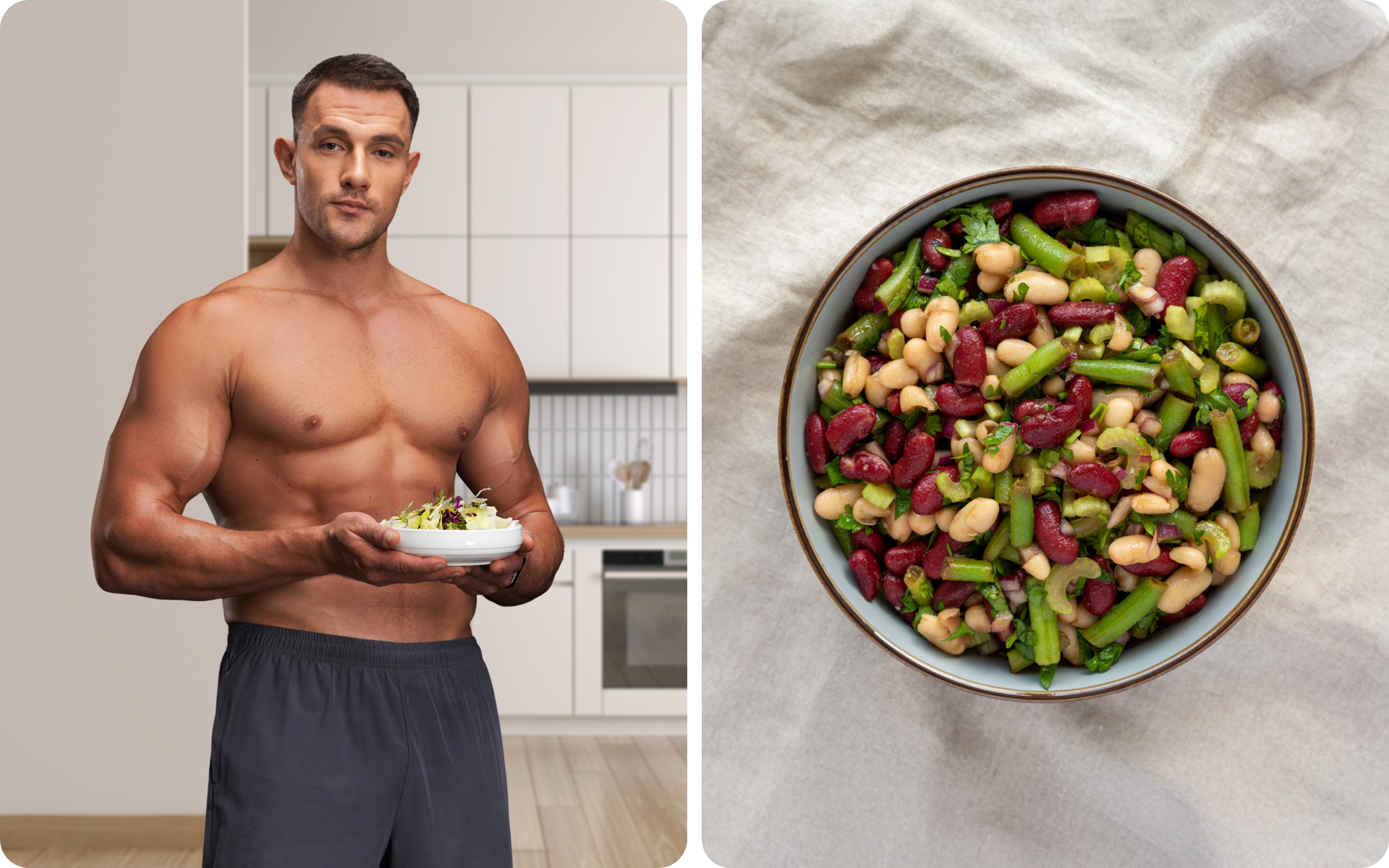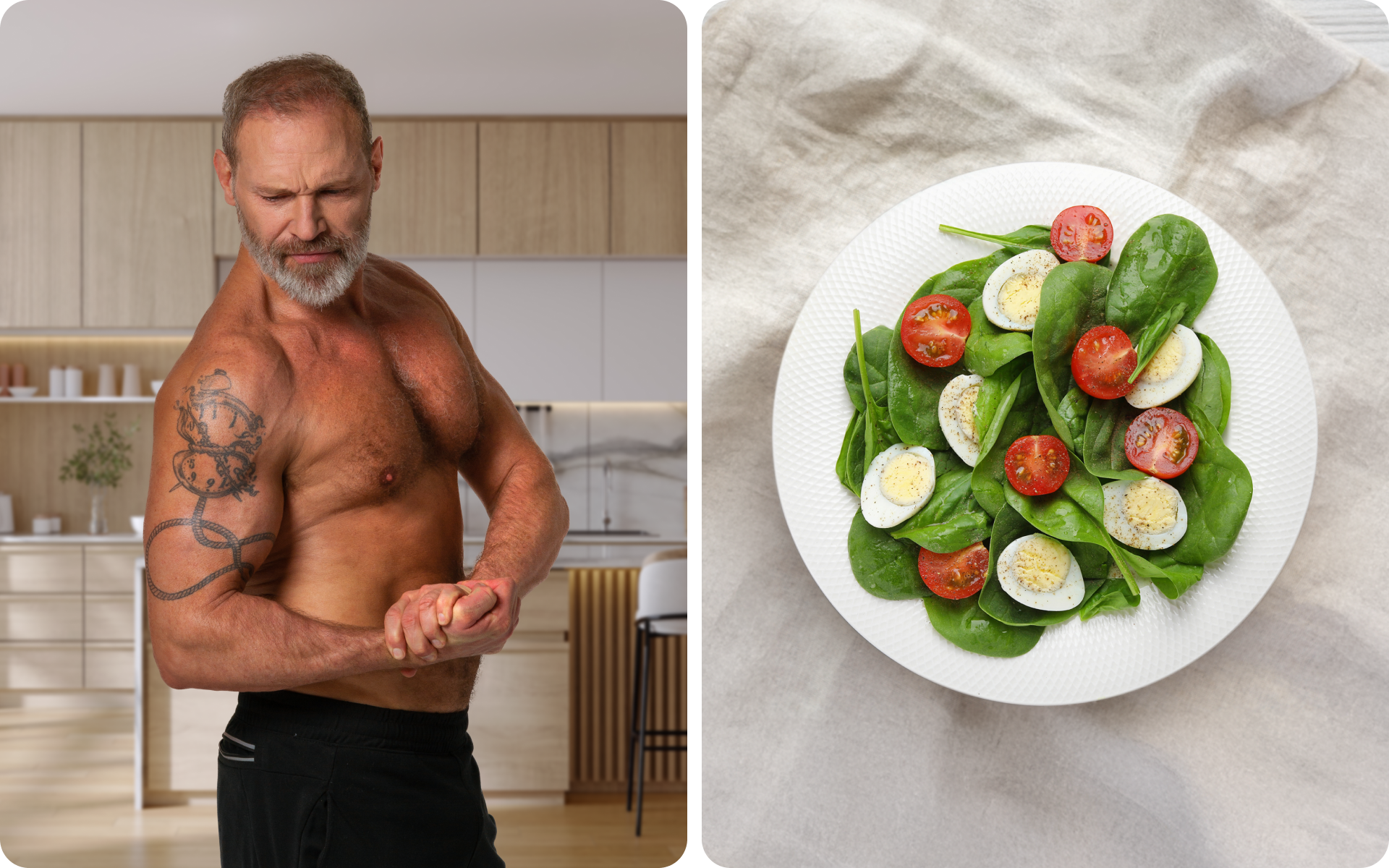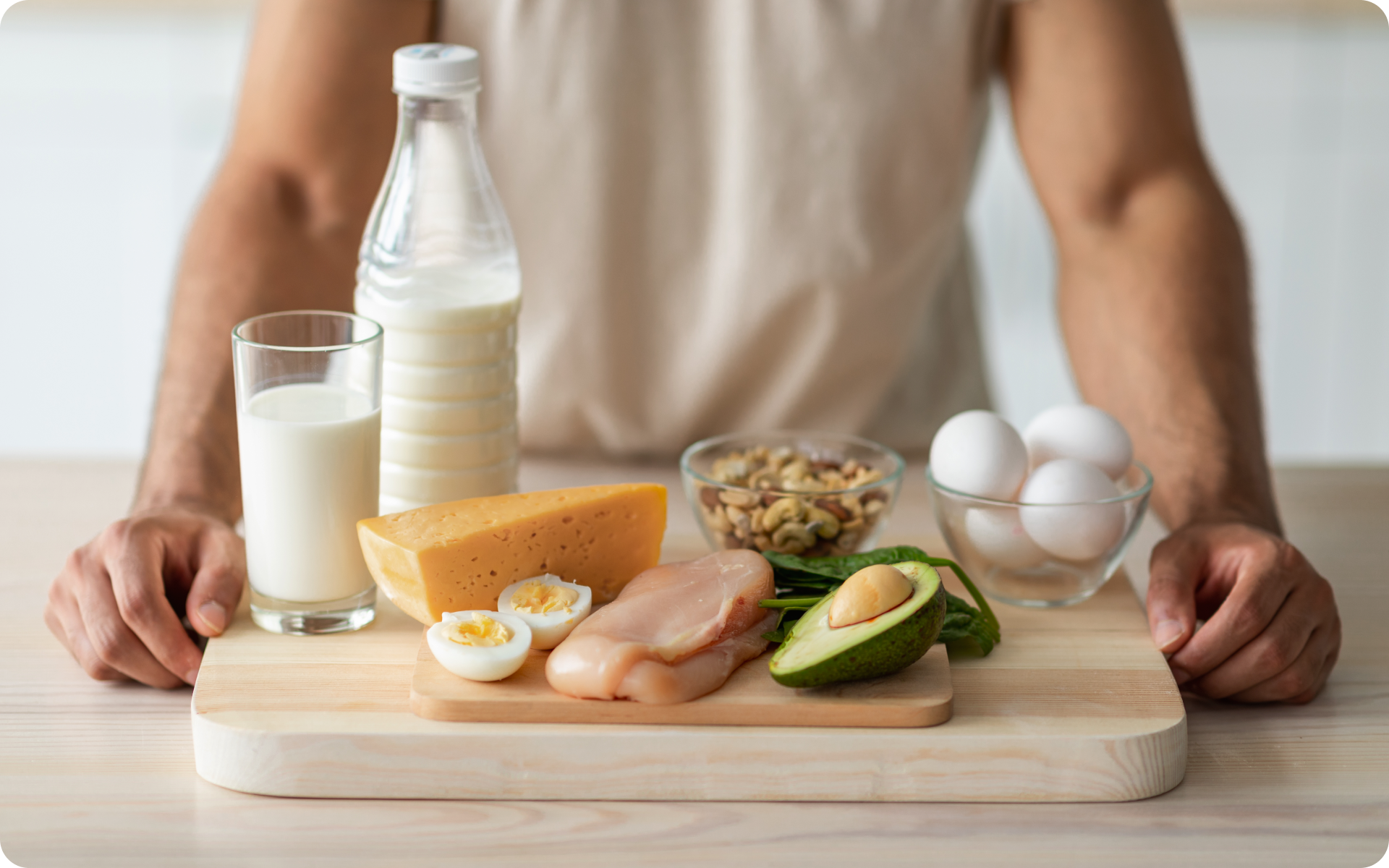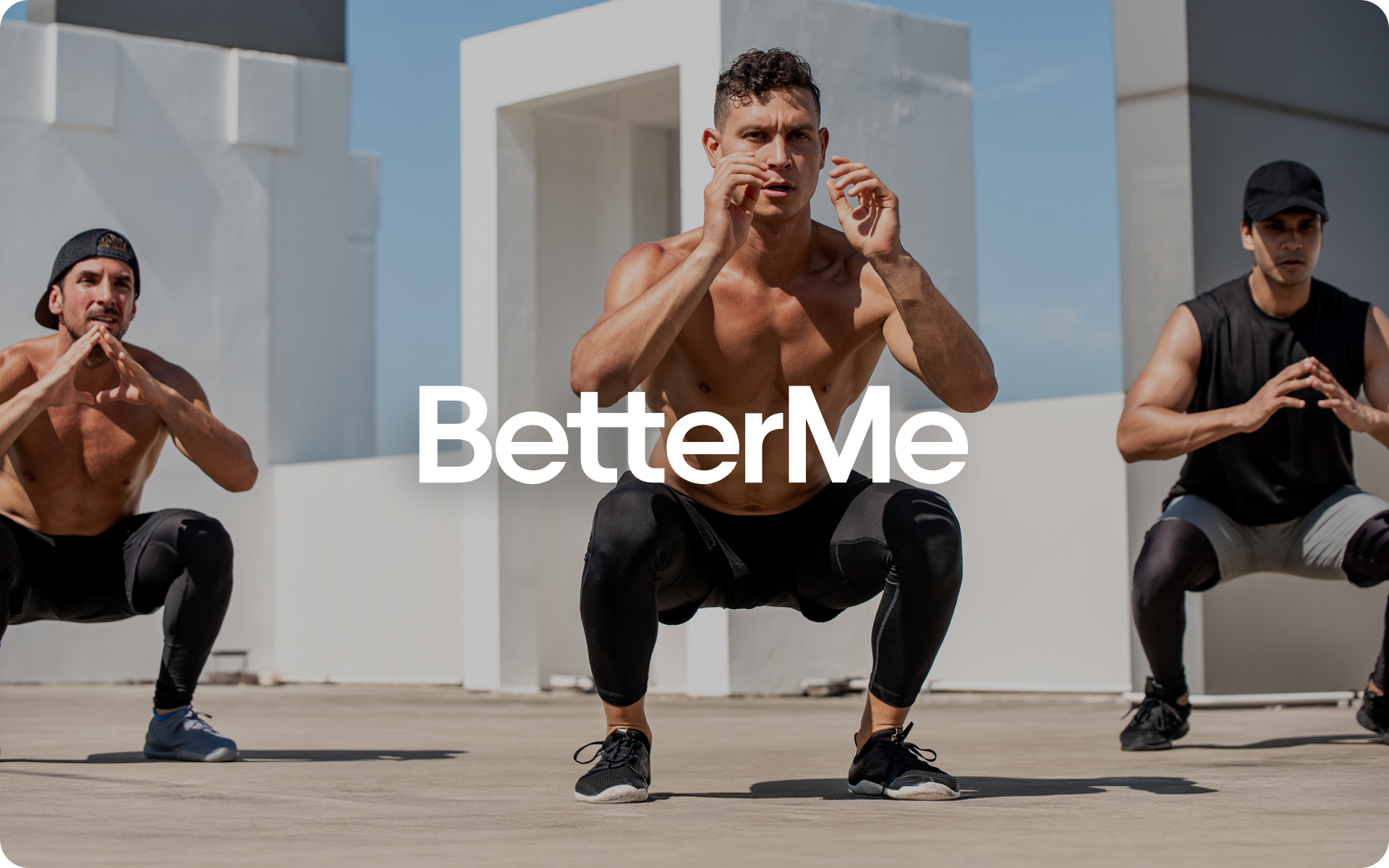In nutrition and fitness, cutting refers to reducing body fat while preserving as much muscle as possible. It’s common among athletes, bodybuilders, or anyone who is aiming to achieve a leaner physique. The process involves eating fewer calories than your body needs (a calorie deficit) while also prioritizing protein and strength training.
However, cutting effectively isn’t as simple as eating less. If it is done wrong, it can lead to muscle loss, energy dips, and poor results.
This guide will walk you through evidence-based strategies for cutting without sacrificing muscle. We’ll explore the right balance of nutrition, exercise, and recovery to help you achieve your goals.
How to Cut Properly as a Beginner
Cutting for the first time can feel challenging, but with strategy and patience, it can be a positive experience. Implementing these evidence-based methods will ensure safety, sustainability, and better results over time.
- Build a Solid Muscle Foundation First
Before starting a cut, it’s important to assess your muscle base. Cutting aims to reveal muscle definition, but there needs to be muscle to show. Without time spent building strength and size through resistance training, cutting may leave you looking smaller rather than leaner. You should plan for at least 6-12 months of consistent strength training before you attempt your first cut.
- Understand and Create a Calorie Deficit
A calorie deficit means eating fewer calories than you burn. This is non-negotiable for fat loss. However, you should aim for a moderate deficit of 300-500 calories per day (1). Too large a deficit can lead to muscle loss, fatigue, and poor performance during workouts. Use a calorie tracking app or consult a professional to calculate your needs based on your age, weight, activity level, and goals.
- Keep Your Protein Intake High
During a cut, muscle preservation requires adequate protein. Aim for 1.6-2.2 grams of protein per kilogram of body weight daily (2). High-protein foods such as lean meats, eggs, fish, tofu, and legumes help maintain muscle, improve recovery, and promote satiety during your deficit (3).
- Time Your Carbs
Carb timing can make a difference, particularly for energy and performance. Save enough of your carbs for pre- and post-workout meals. Carbs eaten before exercise provide energy, while those consumed after help replenish glycogen and help with muscle repair (4). Choose complex carbs such as oats, sweet potatoes, or whole grains rather than refined options.
- Prioritize Resistance Training Over Cardio
Your workouts during a cut should focus on preserving strength and muscle through resistance training. Aim for 3-5 days a week of structured strength sessions. Avoid overloading on cardio, as excessive endurance work can lead to muscle loss when paired with a calorie deficit (5). If you’re adding cardio, you should keep it moderate and complementary to your goals.
Reasons why BetterMe is a safe bet: a wide range of calorie-blasting workouts, finger-licking recipes, 24/7 support, challenges that’ll keep you on your best game, and that just scratches the surface! Start using our app and watch the magic happen.
- Stay Patient and Avoid Drastic Changes
Cutting isn’t a race. Drastic caloric cuts or sudden shifts in exercise routines can overwhelm your body and cause frustration. Gradual adjustments are sustainable and protect your overall health. Monitor your progress every few weeks through body measurements or photos, not just the number on the scale.
- Recovery and Sleep Matter
Muscle maintenance depends on recovery (6). Cutting can place stress on the body, which makes rest even more important. Aim for 7-9 hours of quality sleep per night. Sleep supports muscle repair, hormone balance, and mental focus (7). At the same time, you should avoid overtraining and include rest days as your body needs time to adapt and recover during the calorie deficit.
- Monitor Progress and Adjust
A successful cut is dynamic. Stalling on fat loss or feeling overly fatigued may mean it’s time to slightly adjust your calorie intake, reduce your activity levels, or even take a break from the deficit. Use tools such as progress photos, workout performance metrics, and your overall mood to guide the process.
Read more: Budget-Friendly 1950 Calorie Meal Plan For Weight Loss
How to Start a Cut Without Losing Muscle
Fat loss is reliant on a calorie deficit, but this can sometimes trigger muscle breakdown. The key is to give your body the tools it needs to retain lean tissue while shedding fat.
When your body detects fewer calories coming in, it looks for energy elsewhere. Ideally, it will then target stored fat. However, without certain safeguards, it can also break down muscle for fuel. This happens if your calorie deficit is too extreme or if your body lacks the nutrients it needs to maintain muscle (8).
Muscle is metabolically costly, which means that it requires energy to sustain (9). To convince your body to keep it, you must signal that it’s essential for survival. This is done through proper training and nutrition.
- Protein as the Cornerstone
Proteins are made up of amino acids, which your muscles need to repair and grow (10). When you’re in a calorie deficit, upping your protein intake helps counteract the muscle breakdown that’s triggered by reduced energy. Research has suggested that consuming 1.6-2.2 grams of protein per kilogram of your body weight daily may be helpful (2).
The timing of your protein intake also matters. Spreading it across all meals may boost muscle protein synthesis, the process of building and maintaining muscle (11). Quality is equally important. Prioritize complete protein sources such as chicken, fish, eggs, and dairy, which contain all the essential amino acids, and/or include a variety of plant-based protein sources that complement each other.

- Strength Training Sends the Right Signals
Your muscles need a reason to stick around during a cut. Strength training provides that reason. When you challenge your muscles with resistance, your body recognizes their importance and focuses on retaining them (12).
Avoid the temptation to drastically cut weights or lift lighter during a cut. Stick with heavy, compound lifts such as squats, rows, and overhead presses. Aim for 3-5 strength-focused sessions per week, using good form and a structured plan, and focus on maintaining your current strength levels rather than aiming for rapid gains.
- Carb Timing for Performance and Recovery
Carbohydrates act as your body’s main energy source. Consuming carbs strategically during a cut will ensure you have the energy you need to train hard. It also replenishes glycogen, the storage form of carbs in muscles, which helps with recovery (4).
Target your carb intake around workouts. A pre-workout meal rich in quick-digesting carbs such as fruits provides immediate energy for lifting. Post-workout, complex carbs such as whole grains can refuel glycogen and enhance recovery over several hours. This approach supports performance and muscle preservation without overeating (4).
- Manage Your Calorie Deficit Wisely
A steep calorie cut may seem tempting, but it will push your body into survival mode. When this happens, muscle breakdown accelerates. Instead, you should opt for a modest deficit of 300-500 calories daily (1). This creates a slower, more sustainable fat loss while protecting lean mass.
Check your progress often. If weight loss is rapid (over 1% body weight weekly) (13), adjust your calories upward slightly to reduce the risk of muscle loss. Patience is the key here.
- The Role of Recovery
Muscle preservation extends beyond workouts and meals. Recovery, especially sleep, is essential. Sleep promotes growth hormone release, which helps repair muscle tissue. Aim for 7-9 hours per night to maximize recovery (7).
Overtraining also threatens muscle preservation. Incorporate rest days and listen to your body. Chronic fatigue or declining performance may signal the need to adjust your routine. Recovery time is when your body rebuilds, so don’t overlook it (6).
- Hydration and Micronutrients
During a cut, hydration plays a crucial role in muscle function. Dehydrated muscles are weaker and more prone to catabolism, the breakdown of muscle tissue. Drink water consistently throughout the day, and pay attention to electrolytes, particularly during intense training sessions (14).
Micronutrients such as magnesium, zinc, and vitamin D support muscle repair, energy production, and overall health (15). A well-rounded diet that’s full of colorful fruits, vegetables, and other nutritious foods will ensure you meet these needs.
What’s the Safest Calorie Deficit for Cutting?
A daily deficit of 300-500 calories is recommended for most individuals (1). This range promotes steady fat loss of approximately 0.5 to 1 pound per week (16). It’s slow, but this pace helps protect your muscle mass and keeps your metabolic rate stable.
To calculate your calorie needs (maintenance calories) start by estimating your total daily energy expenditure (TDEE). TDEE includes calories that are burned through your workout, daily activity, and natural bodily functions (17). Online calculators that use your age, weight, height, and activity level can make this easier. Once you know your baseline, subtract 300-500 calories for fat loss.
Use Percentages for More Precision
For a tailored approach, consider a percentage-based deficit. A 10-20% decrease from your TDEE works well for fat loss. This method accounts for differences in body size and energy needs. For example, if your TDEE is 2,500 calories, a 10% deficit would be 250 calories, while a 20% deficit would be 500 calories.

Avoid Extreme Deficits
Going beyond a 500-calorie or 20% deficit can create problems. Rapid fat loss often comes at the cost of muscle tissue (18). Extreme calorie cuts can also lead to fatigue, poor performance, and a higher risk of nutrient deficiencies. Over time, these factors may harm your metabolism and make fat loss harder (19).
Monitor and Adjust
A “safe” or ideal deficit isn’t set in stone. Over time, your TDEE may change as your body weight decreases or activity levels adjust. Regularly track progress through measurements, strength levels, and energy. If your weight loss slows or plateaus, reassess your TDEE and deficit. This will ensure you stay on track without cutting more calories than necessary.
The safest calorie deficit is one you can stick to. If the deficit feels unmanageable or leaves you constantly hungry, you should reduce it (i.e. increase your calorie intake). Fat loss takes time and crashing your calories only increases the risk of burnout or quitting.
Read more: Super Simple Healthy Meal Plan with Grocery List for Beginners
Which Foods Support Effective Cutting?
Foods that are rich in nutrients and low in calories are ideal for supporting effective cutting.
High-Protein Foods
Protein is the nutritional foundation of muscle preservation during a cut. It helps repair and maintain muscle while keeping you feeling full (2). High-protein foods have a thermic effect, which means they require more energy to digest than fats or carbs (3).
Examples of high-protein foods:
- Chicken breast
- Turkey
- Eggs and egg whites
- Lean beef
- Tofu
- Tempeh
- Fish (salmon, tuna, tilapia)
- Shrimp
- Cottage cheese
- Greek yogurt
- Legumes such as beans, peas, and lentils
Low-Calorie, High-Fiber Vegetables
Vegetables are nutrient-dense and low in calories, which makes them ideal for filling up your plate. Their high fiber content helps with digestion, prolongs satiety, and minimizes hunger pangs in a calorie deficit (20)
Examples of low-calorie vegetables:
- Broccoli
- Spinach
- Zucchini
- Cauliflower
- Cucumber
- Bell peppers
- Green beans
- Mushrooms
- Lettuce
- Kale
Complex Carbohydrates
Complex carbs provide steady energy for workouts and recovery. They release glucose gradually, which helps avoid the blood sugar spikes that are linked to refined carbs. Consuming them around workouts supports glycogen replenishment and performance (4).
Examples of complex carbs:
- Sweet potatoes
- Quinoa
- Brown rice
- Oats
- Whole-grain bread
- Legumes (lentils, chickpeas, black beans) – these are also rich in plant-based protein
- Butternut squash
- Barley

Healthy Fats
Dietary fats are essential for hormone production, particularly during a cut. They also improve nutrient absorption and provide long-lasting satiety, making it easier to stick to your calorie target (21).
Examples of healthy fats:
- Avocado
- Nuts (almonds, walnuts, cashews)
- Seeds (chia seeds, flaxseeds, sunflower seeds)
- Olive oil and other plant-based oils that are rich in unsaturated fats
- Fatty fish (salmon, mackerel, sardines)
Hydrating Foods
Hydration is often overlooked but it’s essential during a cut. Foods with a high water content help meet your hydration needs and combat hunger by adding volume to your meals without many calories (22).
Examples of hydrating foods:
- Watermelon
- Cucumber
- Celery
- Strawberries
- Oranges
- Bell peppers
Should You Lift Weights While Cutting?
Yes, you should lift weights while cutting. Strength training is one of the most effective ways to preserve muscle during a calorie deficit (23).
When you’re cutting, your body has fewer calories to use for energy. Without the right stimulus, it may break down muscle tissue along with fat to meet its energy demands. Strength training sends a signal to your body that muscle is essential. This helps shift your body’s focus to burning fat for fuel while preserving lean tissue.
In addition, lifting weights supports your metabolism (24). Muscle burns more calories at rest than fat, so maintaining it during a cut helps prevent a slowdown in metabolic rate. This means you’ll continue to burn calories even outside the gym.
What Kind of Strength Training Should You Do?
When cutting, your focus should be on maintaining strength and muscle rather than chasing new personal bests. Stick to a program that emphasizes compound movements, which work multiple muscle groups at once, such as:
- Squats
- Deadlifts
- Bench presses
- Pull-ups
- Rows
Isolation exercises such as bicep curls or tricep extensions can still be included in your routine. In fact, you can stick to the program you had during the bulk if you feel strong enough to do it. You can lower the weights or decrease the number of repetitions to accommodate your calorie deficit if it feels right.
Aim for 3-5 sessions per week, using moderate to heavy weights. Complete 3-4 sets of 6-12 repetitions per exercise, which is an optimal range for maintaining strength and muscle.
While strength training is important, balance is also key. Too much volume or intensity can overwork your muscles, especially in a calorie deficit. This can hinder recovery and lead to fatigue. Pair your strength training routine with adequate rest days to give your body time to rebuild and adapt.

How to Maintain Energy During a Cut
Stable energy comes down to prioritizing balanced nutrition, proper hydration, and quality sleep, in addition to managing your training intensity. A well-structured plan ensures that your body gets the fuel it needs to perform, even in a calorie deficit.
Here are some strategies to ensure your energy is stable during a cut:
- Distribute Meals Throughout the Day
Eat smaller, balanced meals every 3-4 hours. This helps maintain steady blood sugar levels and prevents energy crashes (25). - Fuel With Complex Carbs
Include slow-digesting carbs such as oats, quinoa, and sweet potatoes. These provide a sustained energy release, which is particularly helpful around workouts (4). - Ensure Adequate Protein
Protein preserves muscle and helps keep you feeling full and energized (3). Focus on lean sources such as chicken, fish, tofu, and eggs. - Don’t Skip Healthy Fats
Add fats such as avocados, nuts, seeds, and olive oil. They provide long-lasting energy and support hormone function (21). - Drink Plenty of Water
Dehydration can lead to fatigue. Aim for at least 8-10 cups of water daily and consider electrolyte drinks during intense workouts (14). - Prioritize Pre- and Post-Workout Nutrition
Have a meal or snack with carbs and protein before your workout for energy. Refuel afterward with a similar combination to aid recovery (26). - Get Quality Sleep
Sleep is essential for energy, recovery, and mental focus. Aim for 7-9 hours each night to keep your body functioning optimally (7). - Adjust Training Volume and Intensity
Avoid overtraining. Incorporate rest days and balance strength work with lighter activities to help prevent burnout. - Use Caffeine Strategically
A moderate dose of caffeine, such as a cup of coffee, can boost focus and performance (27). Avoid relying on it too much, particularly late in the day if it affects your sleep.

How Long Should a Cut Last?
The ideal length of a cutting phase will depend on your goals, starting body composition, and overall health. A cut should last long enough to achieve meaningful fat loss without compromising muscle mass or well-being. On average, most cutting phases range from 6 to 16 weeks.
Consider these factors when planning for a cut:
- Starting Body Fat Percentage
Individuals with higher body fat may safely maintain a cutting phase for a longer time, while those with lower body fat should opt for shorter cuts to avoid excessive muscle loss. - Fat Loss Goals
A realistic fat loss rate is 0.5-1 pounds of body weight per week (13). For example, if you aim to lose 10 pounds, you may need 10-20 weeks, depending on your progress. - Calorie Deficit
The size of your calorie deficit will impact the speed of fat loss. A smaller deficit promotes slower, more sustainable results and preserves muscle. A larger deficit should only be used for short-term cuts under professional guidance. - Physical and Mental Fatigue
Prolonged calorie restriction can lead to fatigue or burnout. If your energy levels drop significantly or your performance declines, it may be time to pause or wrap up your cut. - Plateaus in Progress
Fat loss plateaus are normal during a cut. If adjustments to your diet and exercise no longer yield results after weeks of effort, this could signal the end of your cutting phase.
How to Transition After Cutting
Transitioning out of a cutting phase is just as important as the cut itself. Moving too quickly can lead to weight regain, energy dips, or muscle loss. The goal during this phase is to stabilize your weight, restore energy, and maintain the muscle you’ve preserved or gained. Here’s how to transition effectively:
- Gradually Increase Your Calories
After a cut, suddenly eating at maintenance or surplus levels can cause fat gain. Instead, slowly increase your calorie intake by 50-100 calories per week. This gradual approach will give your body time to adapt and minimize the risk of rapid weight rebound.
- Monitor Progress
Track changes in weight, performance, and energy levels weekly. If your weight stabilizes and energy improves without noticeable fat gain, you’re on the right track. Adjust as needed based on your goals and how your body responds.
- Maintain High Protein Intake
Protein remains important during the transition. It helps protect your muscles and supports recovery from any lingering fatigue. Aim for 1.6-2.2 grams of protein per kilogram of body weight (2), similar to the levels maintained during your cut.
When it comes to weight loss, progress is made by inches, not miles, so it’s much harder to track and a lot easier to give up. The BetterMe: Health Coaching app is your personal trainer, nutritionist, and support system all in one. Start using our app to stay on track and hold yourself accountable!
- Reintroduce Carbohydrates Strategically
Gradually increasing carbs supports restored glycogen levels, better training performance, and more energy. Focus on quality sources such as oats, brown rice, sweet potatoes, and fruit. Pair these with workouts to maximize recovery (4).
- Adjust Training Intensity
After a calorie deficit, your performance may have dipped slightly. With more energy from increased calories, you can slowly up your training intensity. Shift your focus back to progressive overload to rebuild strength while still emphasizing good form (28).
- Prioritize Recovery
The transition phase is a great time to focus on recovery. Ensure you’re sleeping for 7-9 hours a night and incorporating rest days into your routine. This supports hormone regulation and muscle repair as your body adjusts (7).
- Decide Your Next Phase
Once your weight stabilizes and your energy normalizes, determine your next goal. If you’re satisfied with your physique, you can transition to maintenance, or if you want to build more muscle, you can start a lean bulking phase with a slight calorie surplus.
- Stay Consistent
Consistency is key in this stage. Stick to structured training and balanced nutrition. Give your body time to adjust before you make significant changes to your diet or fitness program.
Yes, but it’s challenging. Building muscle while cutting is more likely to happen in beginners, those who are returning to training after a break, or individuals with higher body fat levels. It requires a small calorie deficit, high protein intake, and consistent strength training. For most people, maintaining muscle during a cut is a more realistic goal than building new muscle. The ideal protein intake during a cut is 1.6-2.2 grams per kilogram of body weight daily. This range will help maintain muscle mass, aid recovery, and support satiety while in a calorie deficit. Prioritize high-quality protein sources such as chicken breast, eggs, fish, Greek yogurt, and tofu. If your weight loss has stalled, this could be due to water retention, inaccurate calorie tracking, reduced activity levels, or a calorie deficit that’s too small. Reevaluate your calorie intake, portion sizes, and exercise routine. Remember, fat loss can be slow and isn’t always immediately reflected on the scale. Consider tracking progress through measurements or photos instead. Cheat meals can be included if they’re planned and controlled and they may help with mental flexibility and adherence to your plan. However, overdoing cheat meals can erase your calorie deficit. Stick to one meal per week, keep the portions reasonable, and enjoy it mindfully. Alternatively, incorporate small treats into your overall daily calorie intake to maintain balance.Frequently Asked Questions
Can you build muscle while cutting?
What is the best protein intake for cutting?
Why am I not losing weight on a cut?
Do cheat meals fit into a proper cut?
The Bottom Line
Cutting properly without losing muscle requires strategy, patience, and consistency. By focusing on a moderate calorie deficit, maintaining high protein intake, and prioritizing strength training, you can preserve the muscle you’ve worked hard to build. Proper nutrient timing, hydration, and recovery are equally important for sustaining energy and maximizing results.
DISCLAIMER:
This article is intended for general informational purposes only and does not serve to address individual circumstances. It is not a substitute for professional advice or help and should not be relied on for making any kind of decision-making. Any action taken as a direct or indirect result of the information in this article is entirely at your own risk and is your sole responsibility.
BetterMe, its content staff, and its medical advisors accept no responsibility for inaccuracies, errors, misstatements, inconsistencies, or omissions and specifically disclaim any liability, loss or risk, personal, professional or otherwise, which may be incurred as a consequence, directly or indirectly, of the use and/or application of any content.
You should always seek the advice of your physician or other qualified health provider with any questions you may have regarding a medical condition or your specific situation. Never disregard professional medical advice or delay seeking it because of BetterMe content. If you suspect or think you may have a medical emergency, call your doctor.
SOURCES:
- Calorie Deficit: What To Know (2022, health.clevelandclinic.org)
- Systematic review and meta-analysis of protein intake to support muscle mass and function in healthy adults (2022, pubmed.ncbi.nlm.nih.gov)
- Higher Protein Intake Preserves Lean Mass and Satiety with Weight Loss in Pre-obese and Obese Women (2012, onlinelibrary.wiley.com)
- High-Quality Carbohydrates and Physical Performance (2018, journals.lww.com)
- Does Cardio Burn Muscle? What You Need to Know (2021, blog.lionel.edu)
- EXPLORING THE SCIENCE OF RECOVERY (2024, blog.nasm.org)
- 7 Benefits of Sleep for Exercise Recovery (2021, acefitness.org)
- 3 signs your diet is causing too much muscle loss (2024, theconversation.com)
- Muscle Metabolism (2025, sciencedirect.com)
- Biochemistry, Essential Amino Acids (2024, ncbi.nlm.nih.gov)
- The effect of protein timing on muscle strength and hypertrophy: a meta-analysis (2022, tandfonline.com)
- A Systematic Review with Meta-Analysis of the Effect of Resistance Training on Whole-Body Muscle Growth in Healthy Adult Males (2020, mdpi.com)
- Key Recommendations (n.d., nhlbi.nih.gov)
- Hydration to Maximize Performance and Recovery: Knowledge, Attitudes, and Behaviors Among Collegiate Track and Field Throwers (2021, pmc.ncbi.nlm.nih.gov)
- Exploring the Relationship between Micronutrients and Athletic Performance: A Comprehensive Scientific Systematic Review of the Literature in Sports Medicine (2023, mdpi.com)
- What is the Required Energy Deficit per unit Weight Loss? (2008, pmc.ncbi.nlm.nih.gov)
- Physical Activity Energy Expenditure and Total Daily Energy Expenditure in Successful Weight Loss Maintainers (2020, pmc.ncbi.nlm.nih.gov)
- Weight Loss Strategies and the Risk of Skeletal Muscle Mass Loss (2021, mdpi.com)
- Impact of calorie restriction on energy metabolism in humans (2022, pmc.ncbi.nlm.nih.gov)
- Unravelling the Effects of Soluble Dietary Fibre Supplementation on Energy Intake and Perceived Satiety in Healthy Adults: Evidence from Systematic Review and Meta-Analysis of Randomised-Controlled Trials (2018, mdpi.com)
- Eating healthy fats has many benefits (2022, uclahealth.org)
- Using food to stay hydrated (2024, health.harvard.edu)
- Preserving Healthy Muscle during Weight Loss (2017, sciencedirect.com)
- Increasing muscle mass to improve metabolism (2013, pmc.ncbi.nlm.nih.gov)
- Association between Meal Frequency and Type 2 Diabetes Mellitus in Rural Adults: A Large-Scale Cross-Sectional Study (2023, mdpi.com)
- Timing Your Pre- and Post-Workout Nutrition (2024, eatright.org)
- A review of caffeine’s effects on cognitive, physical and occupational performance (2016, sciencedirect.com)
- Effects of Resistance Training Overload Progression Protocols on Strength and Muscle Mass (2024, pubmed.ncbi.nlm.nih.gov)











